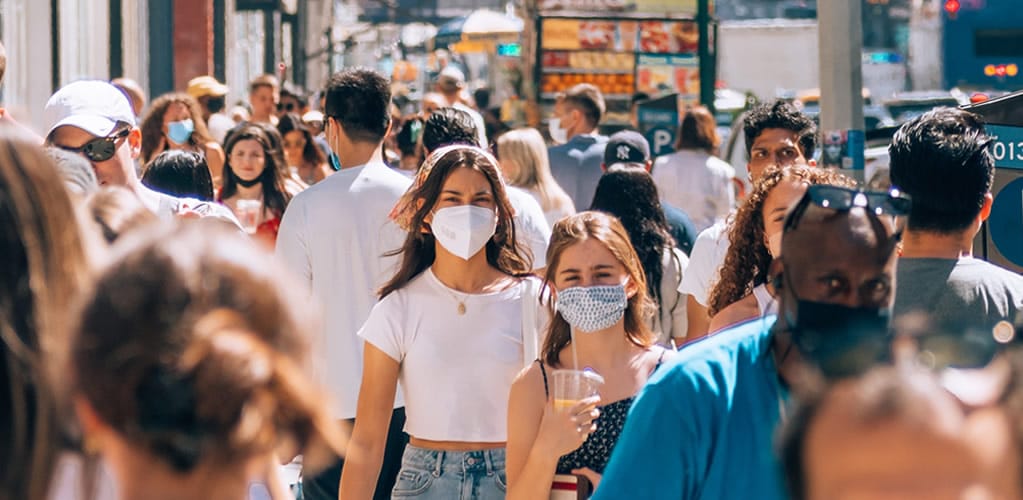Eight changes the world needs to make to live with COVID.
There is no going back to a pre-pandemic normal – only forward to a new one. The world pre-2020 no longer exists.

There is no going back to a pre-pandemic normal – only forward to a new one. The world pre-2020 no longer exists.
First published: February 2022.
More and more people have been asking for a return to normal, and with omicron waning, governments are starting to act. The UK, for example, is removing its remaining public health measures, including mandatory self-isolation of COVID cases and free testing. However, the inescapable truth is that – unless the virus mutates to a milder form – the “normal” life we are returning to will be shorter and sicker on average than before.
We’ve added a new significant disease to our population. COVID is often compared to flu, as if adding a burden equivalent to flu to a population were fine (it isn’t). In fact, COVID has been and remains worse. COVID’s infection fatality rate – the proportion of people who die once they’ve caught it – was initially about ten times higher than for flu. Treatments, vaccines and prior infections have since brought the fatality rate down, but it’s still almost twice as high as for flu – and yes, this still holds for omicron.
The impact is then worsened because COVID is so much more transmissible. It also has a similar or worse longer-term impact on the heart, lungs and mental health than other respiratory diseases, and a higher rate of long-term symptoms. Vaccines have been incredibly effective at reducing severe illness and death, but they’re not perfect. New variants have tested vaccine defences, and protection against infection – and to a lesser extent severe illness – wanes after a few months.
While we’re unlikely to lose all protection against severe illness and death, the sort of return to normal being attempted in countries such as the UK, Denmark and Norway will result in many people facing repeated COVID reinfections over the coming years. The large majority will cope, but some will die, and more will be left with lasting ill health. Many with mild illness will still need time off work or education, and as we have seen with omicron, the aggregate effects can be hugely disruptive. 
In short, the world pre-2020 no longer exists – we may want it to, but it just doesn’t.
Like what you are reading? Please, support our work today!
Support PMP MagazineHow to live post-COVID
The last 150 years have seen vast improvements in public health, with dramatic reductions in deaths from malnutrition, infectious diseases, environmental diseases, smoking and road traffic accidents to name a few.
For communal problems, we have developed communal solutions, from vaccines to controls on pollution, passive smoking, unsafe driving and other ills. There’s nothing normal about upending decades of progress by simply accepting a serious new disease like COVID without actively attempting to mitigate it.
The good news is that we can mitigate it. We can accept that the world has changed and make adaptations based on what we have learned from the last two years. Here are eight key changes that can reduce the future impact of COVID:
- Outdoors is pretty safe – so let’s make indoor air as much like the outdoors as possible. This will involve large investment in infrastructure to improve ventilation and to filter and clean the air. This isn’t simple, but neither was bringing clean water and electricity to every home. We know how to do it and it will be effective against any future variant and any airborne disease.
- Vaccines remain crucial. We need to vaccinate the world as soon as possible to save lives and slow down the emergence of new variants. We also need to keep working towards vaccines that are longer lasting and more variant proof.
- We’ve learned that acting sooner rather than later is crucial to containing outbreaks and preventing spread to other countries. So we need to invest in global surveillance of new COVID variants and other new infectious diseases.
- Most countries already have routine surveillance for serious infectious diseases (such as flu and measles) and plans in place to mitigate their impact. Countries need to add permanent surveillance of COVID infection rates to existing programmes, to keep track of how much COVID is circulating, where and in which communities.
- We still know too little about the long-term impacts of COVID, though we do know it can cause long-lasting organ damage and result in long COVID. We need to invest in understanding, preventing and treating these impacts.
- Many health systems were already struggling before COVID hit, and have since had their resilience further depleted by the pandemic. Investment in health systems is urgently needed, particularly in winter seasons where the additional burden of COVID will be most acutely felt.
- COVID has hit the most disadvantaged the hardest. Those least able to afford to self-isolate are also more likely to work outside the home, use public transport and live in overcrowded housing – all risk factors for catching the virus. Increased exposure is coupled with lower vaccination rates and poorer health among disadvantaged groups, leading to worse outcomes if infected. Countries need to invest more in reducing inequalities: in health, housing, workplaces, sick pay and education. This will make all of us more resilient to future outbreaks and reduce ill health and death – not just from COVID but everything else too.
- Finally, there will still be future waves of COVID – the above will simply reduce their frequency and scale. We need to have a plan to deal with these. Excellent national surveillance systems will help rapidly identify an outbreak and understand how much ill-health is being caused and immunity evaded – all of which will help tailor an appropriate temporary response. A response might, for instance, include escalating testing, reintroducing masks and working from home where possible.
Get TODAY IN COVID in your inbox every day to better understand what happens next with the pandemic.
Become a PMP member todaySuch plans should enable us to avoid long widespread lockdowns. Refusing to learn to live with COVID by pretending the old normal exists is in fact the biggest risk for future lockdowns. 
We need to move on from the denial and anger stages of grief and on to accepting that the world is different now. Then, we can take control and build a way of living that is designed to contain the virus while allowing all of us – including the clinically vulnerable – to lead freer and more healthy lives.

What did you think of this article?
🤩 😀 🤔 😴 😮 😭 🤬 🤯
— AUTHOR —▫ Professor Christina Pagel, Professor of Operational Research, Clinical Operational Research Unit, University College London. Member of Independent SAGE. |
GET THEM INVOLVED: |
Sources
- Text: This piece was originally published in The Conversation and re-published in PMP Magazine on 23 February 2022. | The author writes in a personal capacity.
- Cover: Unsplash/Yoav Aziz. (Licensed under a Creative Commons Attribution-ShareAlike 4.0 International License.)







[Read our Comments Guidelines]